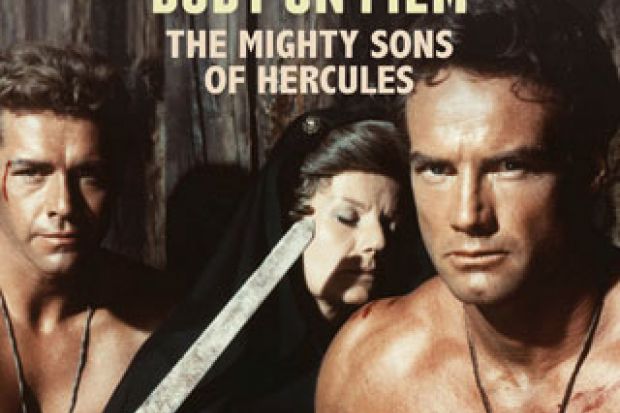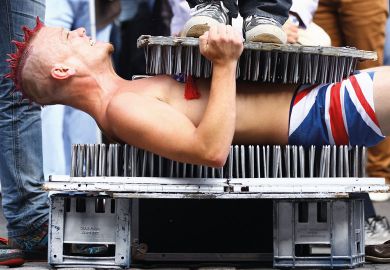In the cult movie musical The Rocky Horror Picture Show, Dr Frank N. Furter determines to create human life and to make for himself the perfect man. He breathes life into a body of exquisite physique, all brawn and no brain. This divine hunk of burning love, clad only in a tiny gold thong, was inspired, he confirms, by nothing less than his passion for old Steve Reeves movies.
Reeves, of course, was the good-looking muscle-clad doyen of the sword and sandal movies known to their critics as “peplum films”, the trashy, kitsch and camp mythological romps popular in the late 1950s and early 1960s. This lowbrow epic genre is the focus of Daniel O’Brien’s book, and he rightly argues that it is a subject worthy of study. He goes about things carefully, exploring the peplums (or “pepla”, as he insists on calling them) from the perspectives of film studies, masculinity studies, feminist theory and racial perspectives. It is all done with an honest regard for scholarship, but the result of his clearly Herculean labour is a thinly disguised reworking of the original doctoral thesis on which this book is so clearly based. The structure smacks of the well-constructed thesis. Combined with endless references to the works of scholars in the field and the myriad citations in parenthesis, the authorial voice gets lost. It’s a pity, because O’Brien has some appealing turns of phrase (describing typical peplum actors as “self-regarding gym-obsessed iron-pumpers” and the genre as “classically inflected”). I wanted to hear more of the bona fide O’Brien.
Much of the book concentrates on Italian-made muscle and myth movies of the era, and O’Brien attempts to theorise and historicise them. (Oddly, given the importance of images to a study of this kind, he has not been well served by his publishers, who provide only a smattering of grainy thumbnails). I’m surprised he didn’t dwell further on the peplums as products of a distinctively Mediterranean culture, in which the strongman image and macho bravado equate social dominance. Mussolini (who gets only the briefest mention) set himself up as a latter-day Hercules and liked nothing more than to be photographed shirtless. His body is an effective image of Italian masculinity and one not too far removed from the Farnese Hercules of classical antiquity. I suspect that the Italian peplums spoke to Italians in the 1950s in a distinct way, set apart from the Americans who viewed them. This was the era of the Charles Atlas wannabe, true, but most American men were content with the beefcake look of Hollywood A-listers such as Rock Hudson and Burt Lancaster, who combined physique with urban sophistication.
A comparison with the male body in 1950s Hollywood epics might have been profitable. Charlton Heston’s Moses in The Ten Commandments and titular role in Ben-Hur, with all their hirsuteness, are more commanding and hold more sex appeal than any muscle-toned peplum actor could deliver, and Kirk Douglas’ toned hero in Spartacus articulates a very different visual message to the boulder-lifting antics of his peplum cousins.
O’Brien reserves some space for a discussion of camp, which the peplum movies – like the American blockbusters of the same era – undeniably are. But he fails to offer a clear definition of this complex term, and what exactly camp is, I fear, remains as elusive as a faded sequin on an old Steve Reeves thong.
Classical Masculinity and the Spectacular Body on Film: The Mighty Sons of Hercules
By Daniel O’Brien
Palgrave Macmillan, 200pp, £60.00
ISBN 9781137384706 and 4713 (e-book)
Published 29 October 2014
Register to continue
Why register?
- Registration is free and only takes a moment
- Once registered, you can read 3 articles a month
- Sign up for our newsletter
Subscribe
Or subscribe for unlimited access to:
- Unlimited access to news, views, insights & reviews
- Digital editions
- Digital access to THE’s university and college rankings analysis
Already registered or a current subscriber? Login




